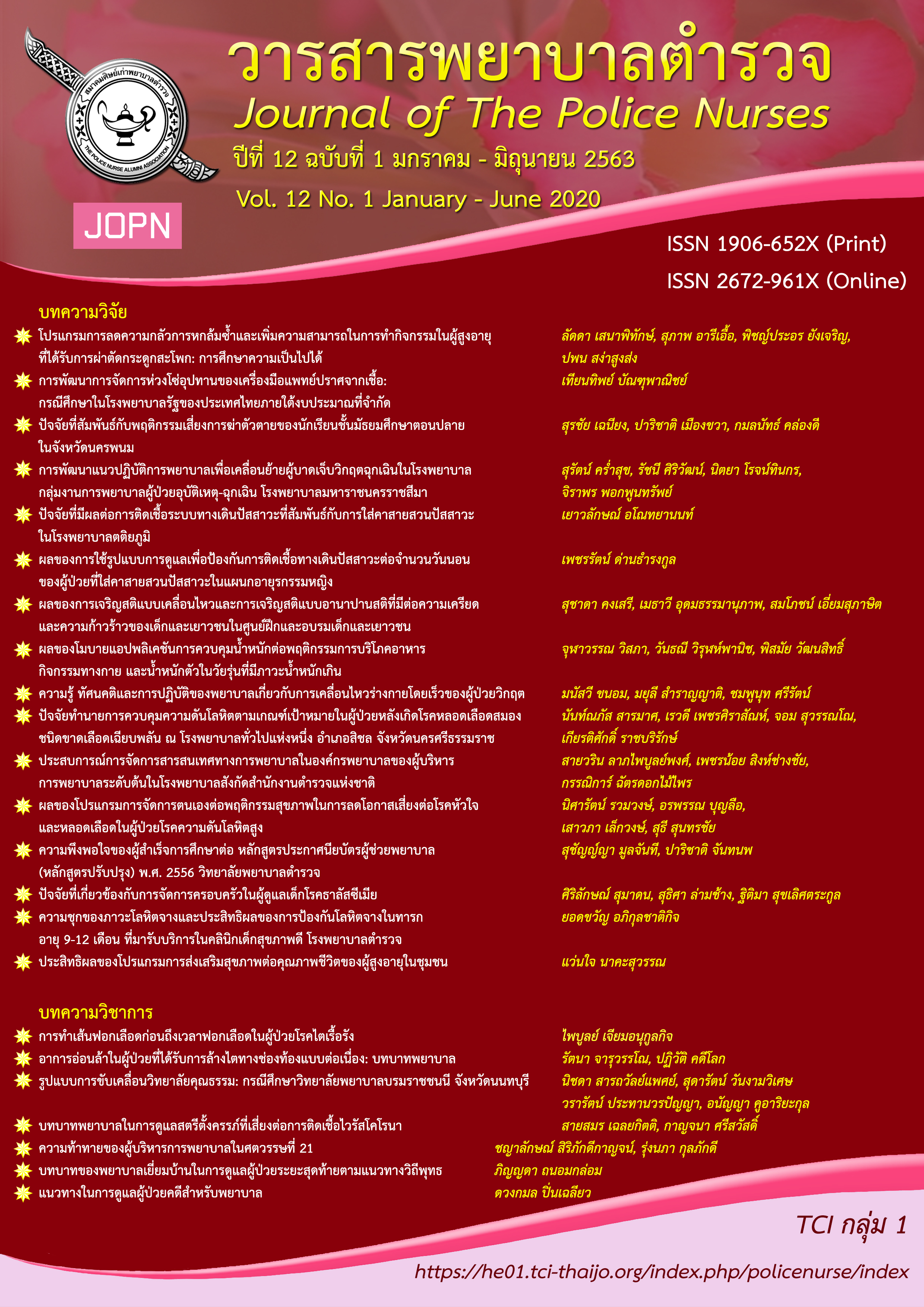FATIGUE AMONG PATIENTS RECEIVING CONTINUOUS AMBULATORY PERITONEAL DIALYSIS: THE NURSE’S ROLE
Keywords:
fatigue, continuous ambulatory peritoneal dialysis (CAPD), nurse’s roleAbstract
Continuous Ambulatory Peritoneal Dialysis (CAPD) is an effective way to remove waste fluids from the body, thus allowing patients to have a better quality of life. However, the treatment may cause certain side effects which can impact their well-being in different ways. One of them is fatigue, which involves the feeling of discomfort, tiredness, lack of energy, and exhaustion, and leads to decreased activity. Indeed, fatigue is the most persistent side effect and takes the greatest toll on the patients’ physical, mental, spiritual, social and economic well-being. It is therefore crucial for the nurses who care for CAPD patients to be able to assess the symptoms of fatigue quickly, precisely, and comprehensively, with regards to all the four aspects, that is, the person and behavior, CAPD, the body, and the mind. This is to formulate a plan to deal with fatigue and improve the patients’ quality of life in line with the nurses’ independent functions in the five following areas: nutrition, sleep, exercise, energy conservation, and mental and spiritual care. As there has been no specific instrument to assess fatigue in this group of patients, research to develop fatigue-related instruments and nursing guidelines is urgently needed to support the role of the nurse in dealing with the patients’ fatigue symptoms in order to improve their well-being.
Downloads
References
Artiwitchayanon, A. (2017). Depression in patients with continuous ambulatory peritoneal dialysis. Burapha Journal of Medicine, 4(2), 67-78.
Berger, A. M., Mooney, K., Alvarez-Perez, A., Breitbart, W. S., Carpenter, K. M., Cella, D., . . . Smith, C. (2015). Cancer-related fatigue version 2 2015. Journal of the National Comprehensive Cancer Network, 13(8), 1012-1039.
Brandenberger, G & Weibel, L. (2004). The 24-h growth hormone rhythm in men: sleep and circadian influences questioned. Journal of Sleep Research, 13(3), 251-255.
Dalopakarn, P. (2002). Factors related to fatigue in breast cancer patients receiving chemotherapy (Master’s thesis). Faculty of Nursing, Chulalongkorn University, Bangkok, Pathumwan. Retrieved from https://cuir.car.chula.ac.th/
Hays, R. D., Kallich, J. D., Mapes, D. L., Coons, S. J., Amin, N., Carter, W. B., & Kamberg, C. (1997). Kidney Disease Quality of Life Short Form (KDQOL-SFtm), Version 1.3: A manual for use and scoring. Santa Monica, CA: RAND Corporation. Retrieved from https://www.rand.org/pubs/papers/P7994.html
Jhamb, M., Weisbord, S. D., Steel, J. L., & Unruh, M. (2008). Fatigue in patients receiving maintenance dialysis: A review of definitions, measures, and contributing factors. American Journal of Kidney Diseases, 52(2), 353-365. doi:10.1053/j.ajkd.20 08.05.005
Joshwa, B., & Campbell, M. L. (2017). Fatigue in patients with chronic kidney disease: Evidence and measures. Nephrology Nursing Journal, 44(4), 337-343.
Ju, A., Strippoli, G. F. M., Craig, J. C., Tong, A., Saglimbene, V. M., Unruh, M. L. (2018a). Interventions for fatigue in people with chronic kidney disease requiring dialysis (Protocol). Cochrane Database of Systematic Reviews, 8. doi:10.1002/14651858.CD 013074
Ju, A., Unruh, M. L., Davison, S. N., Dapueto, J., Dew, M. A., Fluck, R., . . . Tong, A. (2018b). Patient-reported outcome measures for fatigue in patients on hemodialysis: A systematic review. American Journal of Kidney Diseases, 71(3), 327-343.
Kadeelok, P., Jitpanya, C., & Oumtanee, A. (2018). A study of symptom experiences among end stage renal disease patients receiving continuous ambulatory peritoneal dialysis. Thai Red Cross Nursing Journal, 11(2), 171-187.
Krupp, L. B., LaRocca, N. G., Muir-Nash, J., & Steinberg, A. D. (1989). The Fatigue Severity Scale: Application to patients with multiple sclerosis and systemic lupus erythematosus. Archives of Neurology, 46(10), 1121-1123.
Kusoom, W., & Charuwanno, R. (2017). Concept mapping: An effective strategy for clinical teaching in nursing. Pacific Rim International Journal of Nursing Research, 21(4), 263-266.
Leesuk, R. (2006). Effects of providing health information combined with reflexology on insomnia, fatigue, and depression in patients with chronic kidney disease (Master’s thesis). Faculty of Nursing, Chulalongkorn University, Bangkok, Pathum Wan.
Leurmarnkul, W., & Meetam, P. (2005). Properties testing of the retranslated SF-36 (Thai version). Thai Journal of Pharmaceutical Sciences, 29(1-2), 69-88.
Manyanon, W., Waleekhachonloet, O., & Rattanachotpanich, T. (2010). Psychometric properties of the Kidney Disease Quality of Life Short Form (KDQOL-SFTM) Thai version. Thai Journal of Pharmacy Practice, 2(1), 15-23.
McHorney, C. A., Ware, J. E., Lu J. F. R., & Sherbourne, C. D. (1994). The MOS 36-Item Short-Form Health Survey (SF-36): III. Tests of data quality, scaling assumptions, and reliability across diverse patient groups. Medical Care, 32(1), 40-66.
Monthaisong, D. (2010). Fatigue experience, management strategies, and quality of life in continuous ambulatory peritoneal dialysis patients (Master’s thesis). Faculty of Graduate Studies, Mahidol University, Nakhon Pathom. Retrieved from https://tdc.thailis.or.th/tdc/basic.php
Pachotikarn, C., & Atchawananthakun, B. (2013). Chapter 22 Nutrition management for Thai community and special population. In T. Kanjanabuch (Ed.), Textbook practical peritoneal dialysis (pp. 699-732). Bangkok: Sirivatana Interprint Public Co.
Piper, B. F., Lindsey, A. M., & Dodd, M. J. (1987). Fatigue mechanisms in cancer patients: Developing nursing theory. Oncology Nursing Forum, 14(6), 17-23.
Piper, B. F., Dibble, S. L., Dodd, M. J., Weiss, M. C., Slaughter, R. E., & Paul, S. M. (1998). The revised piper scale: Psychometric evaluation in women with breast cancer. Oncology Nursing Forum, 25, 677-684.
Poosumang, T. (2003). Effects of using exercise and health education program on fatigue of acute myocardial infarction patients (Master’s thesis). Faculty of Nursing, Chulalongkorn University, Bangkok, Pathum Wan.
Rosenthal, T. C., Majeroni, B. A., Pretorius, R. & Malik, K. (2008). Fatigue: An overview. American Family Physician, 78(10), 1173-1179.
The Nephrology Society of Thailand. (2015). Thailand renal replacement therapy year 2015. Retrieved from http://www.nephrothai.org/images/Final_TRT_report_2015
Downloads
Published
How to Cite
Issue
Section
License
ผลงานที่ได้ตีพิมพ์แล้วจะเป็นลิขสิทธิ์ของวารสารพยาบาลตำรวจ















